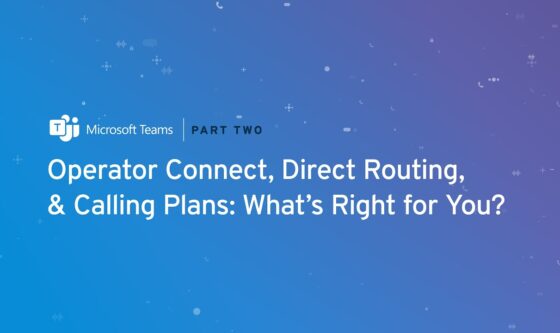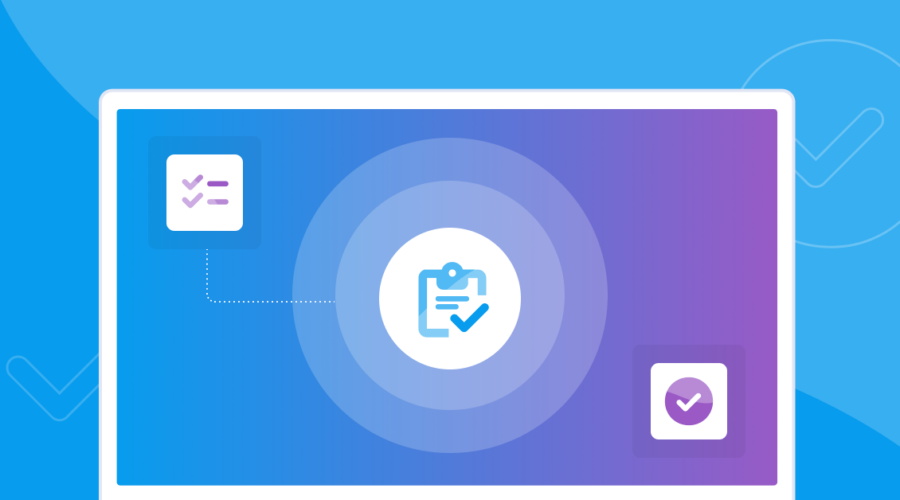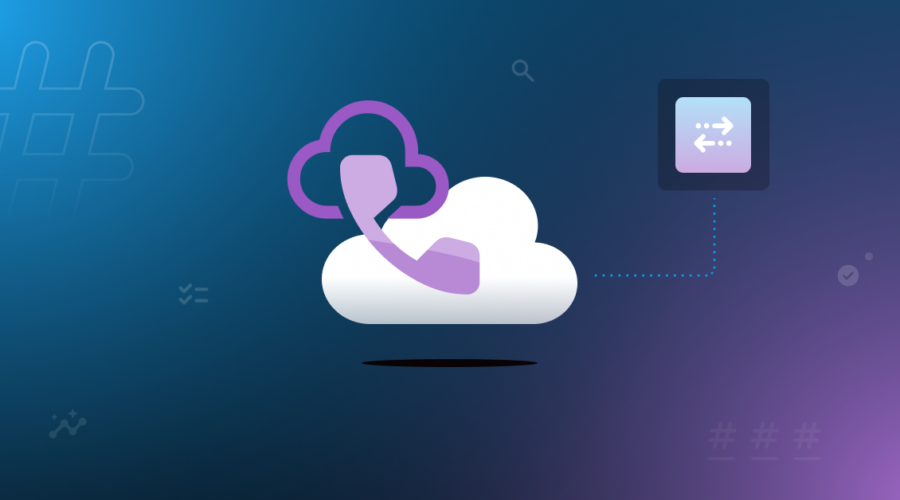IT leaders who want to enable PSTN connectivity within Microsoft Teams have a myriad of options. You can use Microsoft’s Calling Plans, or go straight to the source with Direct Routing or Operator Connect.
If you already know you want a direct line to your voice, emergency calling, and messaging provider, should you choose the tried-and-tested method of Direct Routing, or give Operator Connect a go?
Organizations worldwide are faced with this very decision, and we’re here to help you pick the right telephony solution for your goals.
Three ways to add PSTN connectivity in Microsoft Teams
Microsoft Teams doesn’t automatically come with PSTN connectivity. Instead, organizations get Voice over Internet Protocol conferencing and messaging, which lets you connect to other users within your organization.
You don’t have Direct Inward Dial (DID) numbers and can’t call outside of the platform, so you can’t place calls without leaving the platform and using another softphone or device.
To make Microsoft Teams a full-stack unified communications solution and connect users to the PSTN, you have three options:
- Calling Plans: Offered on a per-user, per-month basis with a set number of minutes.
- Direct Routing: A Bring Your Own Carrier (BYOC) solution that connects carrier services to Microsoft Teams via SBC.
- Operator Connect: A BYOC solution with SBC-as-a-service, that allows you to add PSTN connectivity from the Microsoft Teams Admin Center from third-party carriers, or “operators.”
What is Operator Connect for Microsoft Teams?
Operator Connect is the second evolution of Microsoft Teams’ popular Bring Your Own Carrier (BYOC) solution, Direct Routing. The Teams Admin can choose from a list of Microsoft-certified Operators to connect employees to voice, emergency calling, and texting, without leaving Microsoft Teams.
It’s easy to purchase phone numbers and assign them to employees and doesn’t require a lot of technical knowledge.

Note: For organizations with employees in the U.S., you’re required to comply with E911 laws such as RAY BAUM’s Act and Kari’s Law. As an important piece of compliance, you need E911 Dynamic Location Routing so your users can place a successful 911 call. Consult with your legal counsel for more information on how these laws apply to your organization.
What are the benefits of Operator Connect?
The biggest benefit of this PSTN connectivity solution? It’s intuitive, easy to use, and all within Microsoft Teams—so you can save time and resources trying to manage numbers & users.
However, there are many other reasons why an organization should choose Operator Connect:
- User-friendly: The biggest benefit of Operator Connect is its streamlined telephony management. You can add and manage voice and emergency calling to Microsoft Teams, assign phone numbers to users, and manage connectivity without PowerShell or technical knowledge.
- Pure cloud: Your Operator fully manages your SBCs, so you can migrate 100% of your comms to the cloud and lower costs on hardware purchases and management.
- Truly unified communications: Employees can make calls to mobile and landline phones, and access emergency services directly through Microsoft Teams with their work number.
- Higher quality calling experiences: You can pick a provider with the network quality, global reach, regulatory expertise, and monitoring needed for a positive communications experience. Operators also provide direct peering powered by Azure for a 1-to-1 network connection.
- Better, faster support: You’ll get shared Service Level Agreements (SLAs) from Microsoft and your Operator, and a direct line to support, for efficient troubleshooting and a faster time to resolution. Some operators place more emphasis on support than others, so look for a provider that can meet your needs.
- Feature flexibility: Depending on your Operator, you can add unique features like built-in texting.
How does Operator Connect work?
To deploy Operator Connect in Microsoft Teams, you need a Microsoft Teams License that includes Phone Systems and:
- Activated TeamsOnly mode
- A Microsoft-certified Operator (SIP provider)
- A Microsoft-certified E911 Provider
Once this is set up, you can select and activate your Operator from Microsoft Teams. You can filter by geography and services to find a list of Microsoft-certified operators that meet your criteria within the Admin Center:

From there, provide your contact information to the operator. Each operator’s contracting process will look different, but after you’ve selected your operator and onboarded, you can add your operator and save changes in the Admin Center.
What is Teams Phone (Formerly Operator Connect) Mobile?
In October 2022, Microsoft announced the general availability of Microsoft Teams Phone Mobile.
Formerly Operator Connect Mobile, this is generally available, and lets you use a single phone number across your company-provided mobile phone, desk phone, and Microsoft Teams.
Your mobile number will ring in Microsoft Teams, and you’ll have a single voicemail across Teams and your cell phone. This is limited to specific carriers that are certified integrators in Microsoft Teams and only works with dedicated business numbers.
Microsoft Teams Phone Mobile doesn’t require an additional license, so you simply pay your carrier for their rates.
What is Operator Connect Conferencing?
Microsoft’s Operator Connect Conferencing allows you to manage conferencing and add dial-in numbers into the Conferencing bridge through the Admin Center. You can bring any participating operator into the conferencing environment and increase geographical coverage with technical guidance from your provider.
Now that you know all about Operator Connect, let’s cover its predecessor: Direct Routing.
Enterprise Communications Landscape 2024
Hear how 1,000 IT leaders are improving employee experiences and migrating to the cloud.

What is Direct Routing?
Direct Routing is a Bring Your Own Carrier (BYOC) solution that allows organizations to connect their own provider for voice, emergency, and messaging, much like Webex is for Cisco.
For end users, Direct Routing works the same as Operator Connect. But for Admins and IT leaders, configuring and managing telephony is quite different.
What are the benefits of Direct Routing?
Direct Routing allows you to choose your communications provider for benefits like:
- Flexibility: If you choose Direct Routing, you get more control over your Direct Inward Dial (DID) numbers, dial plan, call flows, and locations. This means you can migrate how you want, when you want, to Microsoft Teams. You can also integrate with contact centers, analytics software, and more to build your communications ecosystem to fit your needs.
- Global reach: Calling Plans are currently available in 16+ countries, but what if you’re doing business where they don’t offer PSTN connectivity? Direct Routing (and Operator Connect) allow you to find a voice provider with full-stack replacement everywhere you’re doing business.
- Hybrid or pure cloud: Sometimes, you need to keep your SBCs and on-prem equipment. If you’re migrating in phases, integrating with analog devices like elevator phones, supporting multiple UCaaS/CCaaS vendors, need PBX co-dependence, or need local PSTN survivability, Direct Routing allows you to communicate in a hybrid environment (or go completely cloud—when you’re ready).
- Dedicated support: You’ll get a close working relationship with your voice provider for faster support, migration control, and cost savings.
Although Direct Routing is more complicated than Operator Connect, it offers the feature flexibility and control that global enterprise communications often require.
Which option is better for you?
If you need complete control over your telephony, want to keep some on-prem equipment, and have coding skills, then Direct Routing is still perfect for you.
If you value ease of use and don’t want to manage your SBCs in-house, give Operator Connect a go.
Wrapping it up: Direct Routing vs. Operator Connect
Direct Routing and Operator Connect are attempting to solve the same challenges in different ways. They both offer flexibility and control as you migrate to Microsoft Teams, and give you the direct-carrier relationship many organizations want.
| Direct Routing | Operator Connect | |
| Vendors | Any communications provider | Microsoft-certified Operators |
| Number provisioning | IT Admin assigns phone numbers and policies with PowerShell | Numbers visible in the Microsoft Teams Admin Center |
| Coverage | North America, if hosted Global if not hosted |
Global |
| Cost of ownership | Keep your SBCs, or let Bandwidth host | Bandwidth fully hosts your SBCs |
| Location | Pure cloud, hybrid, or on-prem | Pure cloud |
| Support | Bandwidth Tier 1 Support with escalations through Microsoft 365 or Premier Support | Bandwidth Tier 1 Support and Shared Service Level Agreements (SLAs) with Microsoft |
| Emergency calling | E911 Dynamic Location Routing & emergency calling | E911 Dynamic Location Routing & emergency calling |
| Texting | SMS and MMS available* | SMS and MMS available* |
| Number procurement | Available in the Bandwidth dashboard | Available in the Bandwidth dashboard |
| Number management | Available in the Bandwidth Dashboard or APIs | Available in the Bandwidth Dashboard or APIs |
Jumpstart your Microsoft Teams telephony
To learn more about Operator Connect, check out these resources:




